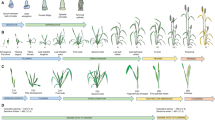Summary
Major changes in the behaviour of the Australian wheat crop over the last one hundred years have been associated with three major gene groupings. The significance of major genes in monitoring response to vernalization, photoperiod and gibberellin, reveals a more optimistic future for breeding programmes where simple genetic and physiologic studies are integrated within those programmes.
A revised classification of growth habit is presented in the appendix.
Similar content being viewed by others
References
Allan, R. E., O. A. Vogel & C. J. Peterson, 1968. Inheritance and differentiation of semi-dwarf culm length of wheat. Crop Science 8: 701–704.
Allan, R. E., 1970. Differentiating between Norin 10/Brevor 14 semi-dwarf genes in a common genetic background. Seiken Zihô 22: 83–90.
Cooper, J. P., 1981. The manipulation of genetic systems in plant breeding. Cambridge, U.K.; Cambridge University Press. 431–440.
Dalrymple, D. A., 1980. Developmental and spread of semi-dwarf varieties of wheat and rice in the United States. An international perspective. United States Department of Agriculture, Agricultural Economics Report No 455.
Evans, L. T. & I. F. Wardlaw, 1976. Aspects of the comparative physiology of grain yield in cereals. Advances in Agronomy 28: 301–359.
Evans, L. T., 1980. The natural history of crop yield. American Scientist 68: 388–397.
Gale, M. D. & C. N. Law, 1976. The identification and exploitation of Norin 10 semi-dwarfing genes. Cambridge, Plant Breeding Institute, Annual Report: 21–35.
Gale, M. D. & Geraldine A. Marshall, 1978. A classification of the Norin 10 and Tom Thumb dwarfing genes in hexaploid bread wheats. Proceedings Fifth International Wheat Genetics Symposium 2: 995–1001.
Johnson, V. A. et al., 1970. Winter wheat breeding. Proceedings third F.A.O./Rockekfeller Foundation Wheat Seminar, 145 pp.
Keim, D. L., J. R. Welsh & R. L. McConnell, 1973. Inheritance of photoperiodic heading response in winter and spring cultivars of bread wheat. Canadian Journal Plant Science 53: 247–250.
McIntosh, R. A., 1973. A catalogue of gene symbols for wheat. Proceedings Fourth International Wheat Genetics Symposium 893–937.
Macindoe, S. L., 1937. An Australian ‘winter’ wheat. Journal Australian Institute Agricultural Science 3: 219–224.
Macindoe, S. L. & C. Walkden Brown, 1968. Wheat breeding and varieties in Australia. New South Wales, Department Agriculture, Science Bulletin No. 76.
Passioura, J. B., 1981. In: Wheat science — today and tomorrow. Evans, L. T. & W. J. Peacock (Eds), Cambridge, UK; Cambridge University Press. 191–201.
Pugsley, A. T., 1964. Semi-dwarf wheats for Australia. Journal Australian Institute Agricultural Science 30: 166–168.
Pugsley, A. T., 1965. Inheritance of a correlated day-length response in spring wheat. Nature 207: 108.
Pugsley, A. T., 1966. The photoperiodic sensitivity of some spring wheats with special reference to the variety Thatcher. Australian Journal Agricultural Research 17: 591–599.
Pugsley, A. T., 1977. A genetic analysis of the spring-winter habit of growth in wheat. Australian Journal Agricultural Research 2: 21–31.
Pugsley, A. T., 1972. Additional genes inhibiting winter habit in wheat. Euphytica 21: 547–552.
Pugsley, A. T., 1980. Wheat breeding in the 1980s and beyond. Wheat Research 5(1): 4.
Radley, M., 1970. Comparison of endogenous gibberellins and response to applied gibberellin of some dwarf and tall wheat cultivars. Planta 92: 292–300.
Syme, J. R., 1970. A high-yielding Mexican semi-dwarf wheat and the relation of yield to harvest index and other varietal characteristics. Australian Journal Experimental Agriculture and Animal Husbandry 10: 350–353.
Syme, J. R. & A. T.Pugsley, 1925. A Mexican wheat and its application to Australian wheat improvement. Sabrao Journal 7(1): 1–5.
Turner, J. S., 1981. the development of plant physiology in Australia. In: Carr, S. G. M. & D. J. Carr (Eds), Plants and man in Australia New York, Academic Press.
Author information
Authors and Affiliations
Rights and permissions
About this article
Cite this article
Pugsley, A.T. The impact of plant physiology on Australian wheat breeding. Euphytica 32, 743–748 (1983). https://doi.org/10.1007/BF00042154
Received:
Issue Date:
DOI: https://doi.org/10.1007/BF00042154



